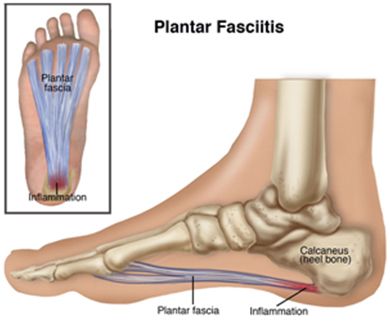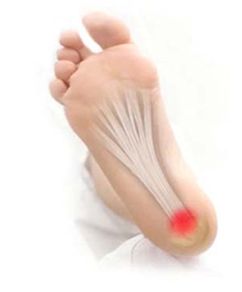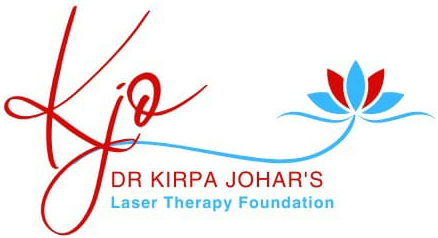Plantar fasciitis is one of the most common explanations of heel pain. It is caused by inflammation to the thick band that connects the toes to the heel bone, called the plantar fascia, which runs across the bottom of your foot.
The condition is most commonly seen in runners, pregnant women, overweight people, and individuals who wear inadequately supporting shoes.
Plantar fasciitis typically affects people between the ages of 40 and 70.

Symptoms
Plantar fasciitis commonly causes a stabbing pain in the heel of the foot, which is worse during the first few steps of the day after awakening. As you continue to walk on the affected foot, the pain gradually lessens. Usually, only one foot is affected, but it can occur in both feet simultaneously.
Treatment
Treatment for plantar fasciitis includes medication, physical therapy, shock wave therapy, or surgery.

Medications
Non steroidal anti-inflammatory drugs (NSAIDs) and Corticosteroids are used to treat the inflammation and pain of plantar fasciitis. Corticosteroids are applied either as a topical solution in conjunction with a non-painful electric current or through injections to the affected area.
Physical therapy
Stretching exercises for the plantar fascia are recommended to relieve pain and aid in the healing process. Sometimes application of athletic tape is recommended.
In moderate or severe cases of plantar fasciitis, your doctor may recommend you wearing a night splint, which will stretch the arch of your foot and calf while you sleep. This helps to lengthen the Achilles tendon and plantar fascia for symptom relief.
Depending on the severity of your plantar fasciitis, your physician may prescribe a store-bought orthotic (arch support) or custom-fitted orthotic to help distribute your foot pressure more evenly.
Surgery and other procedures
When all else fails, surgery may be recommended to detach the plantar fascia from the heel bone. Few people need surgery to treat the condition.
Home remedies
Stretching your plantar fasciitis is something you can do at home to relieve pain and speed healing. Ice massage performed three to four times per day in 15 to 20 minute intervals is also something you can do to reduce inflammation and pain. Placing arch supports in your shoes absorbs shock and takes pressure off the plantar fascia.
Low Level Laser Therapy Treatment for Plantar Fasciitis
Low Level Laser Therapy (LLLT) is the application of red and near infrared light over injuries to stimulate cellular repair. Physiological Effects of LLLT –
- Anti-inflammatory, analgesic, and anti-edematous
- Increased microcirculation
- Increased cellular activity
- Increased rate of tissue regeneration and wound healing
Resulting in –
- Reduced pain and inflammation
- Accelerated tissue repair and cell growth
- Faster healing of injury
- Reduced fibrous tissue formation
You will be encouraged to move the affected area within range of movement/pain but not exert stretch or force during the healing phase.
Once tissues are healed, pain is eliminated and normal range of motion and function is restored. Then muscle and tendon strength and flexibility can be addressed with graduated exercises and stretching.
LLLT has no known side effects, is safe and effective.
